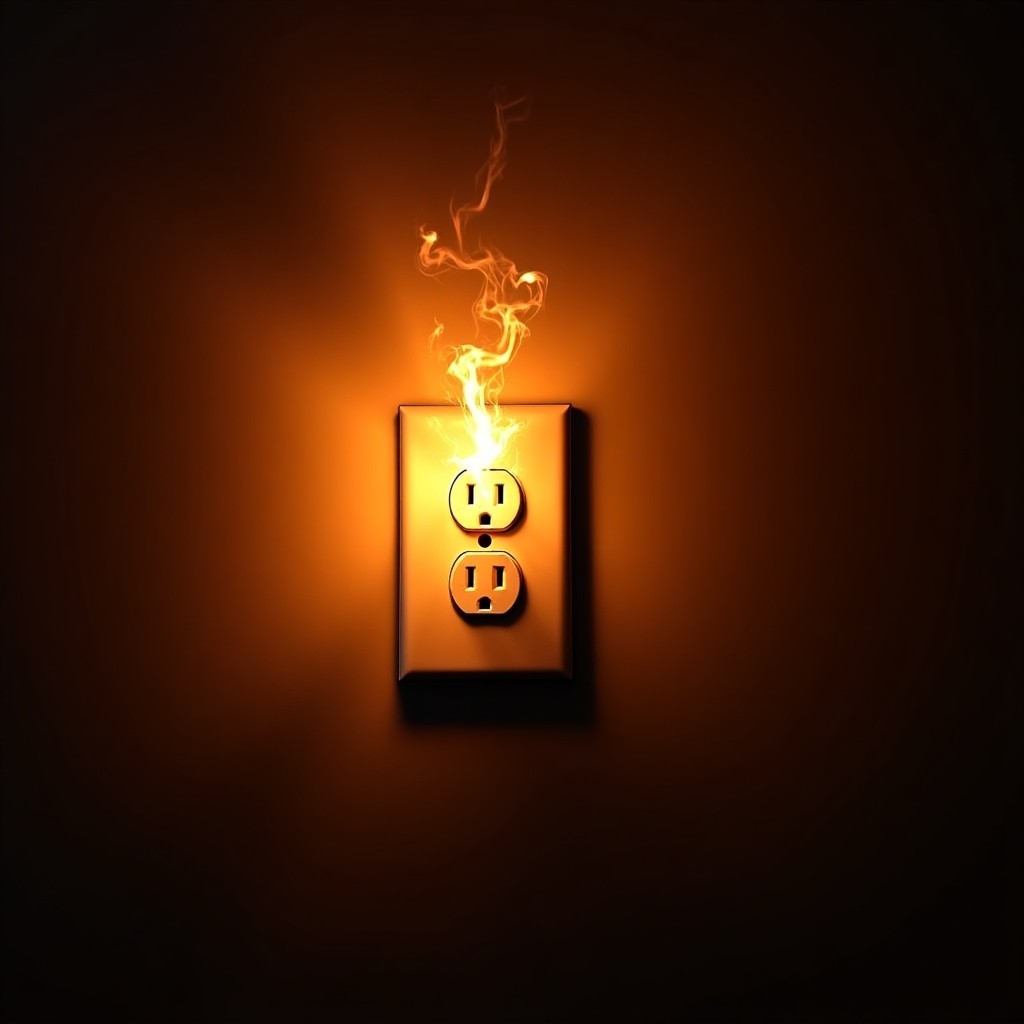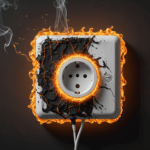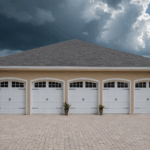Recognizing the warning signs of overloaded circuits is crucial for electrical safety and fire prevention in your home. The most immediate red flag is frequently tripping circuit breakers or blown fuses, which occur when too much current flows through the circuit. If you find yourself repeatedly resetting breakers, this is your electrical system’s way of preventing potential hazards.
Pay close attention to these tell-tale indicators of circuit overload:
- Warm or discolored wall plates on outlets and switches
- Burning odors coming from outlets or wiring
- Buzzing sounds from outlets or switches
- Mild shock or tingling sensation when touching appliances
- Dimming or flickering lights, especially when major appliances turn on
- Outlets that feel warm to the touch
- Cracking, sizzling, or buzzing sounds behind walls
| Severity Level | Signs | Required Action |
| Minor | Occasional dimming lights, warm outlets | Monitor and redistribute loads |
| Moderate | Frequent breaker trips, buzzing sounds | Immediate load reduction needed |
| Severe | Burning smells, discolored outlets | Stop using circuit, call electrician |
Physical symptoms of overloaded circuits may also manifest in your electronic devices. Computers might unexpectedly shut down, appliances may not run at full power, or electronics could operate more slowly than usual. These signs often appear before more serious problems develop, giving you an opportunity to address the issue before it becomes dangerous.
Remember that overloaded circuits can occur in any part of your home, but they’re most common in areas where multiple high-power devices operate simultaneously, such as kitchens, home offices, and entertainment centers. Being vigilant about these warning signs can help prevent electrical fires and ensure the safety of your home’s electrical system.
Common causes of circuit overload
Understanding what causes circuit overload is essential for maintaining electrical safety in your home. Several common situations and practices can lead to dangerous circuit conditions that may require immediate attention.
- Too Many Power-Hungry Devices
- Running multiple high-wattage appliances on the same circuit
- Using space heaters or air conditioners alongside other equipment
- Operating several power tools simultaneously
- Improper Use of Extension Cords and Power Strips
- Daisy-chaining multiple power strips together
- Using lightweight extension cords for heavy-duty appliances
- Overloading power strips beyond their rated capacity
- Outdated Electrical Systems
- Old wiring not designed for modern power demands
- Insufficient number of circuits for household needs
- Deteriorated or damaged wiring insulation
High-demand appliances that commonly contribute to overloaded circuits include:
- Electric ovens and ranges (4,000-8,000 watts)
- Clothes dryers (3,000-4,000 watts)
- Water heaters (3,500-4,500 watts)
- Microwave ovens (600-1,500 watts)
- Hair dryers (1,200-1,875 watts)
Modern homes with multiple electronic devices, smart appliances, and charging stations are particularly susceptible to circuit overload. The increasing number of gadgets and appliances in our daily lives often exceeds what older electrical systems were designed to handle. For fire prevention, it’s crucial to understand that each circuit in your home has a specific amperage rating, typically 15 or 20 amps, and exceeding this limit consistently can lead to hazardous conditions.
Seasonal factors can also contribute to overloaded circuits. During winter, the increased use of space heaters and holiday lighting can strain electrical systems. Similarly, summer months see higher demands from air conditioning units and pool equipment, potentially pushing circuits beyond their capacity.
Testing your electrical circuits
Basic Circuit Testing Steps:
1. Locate your circuit breaker panel and ensure it’s properly labeled. If labels are missing or unclear, document which breakers control specific areas and outlets in your home.
2. Use a digital multimeter to test voltage at outlets:
– Set the multimeter to AC voltage (usually 200V setting)
– Insert the black probe into the neutral slot (larger)
– Insert the red probe into the hot slot (smaller)
– A reading between 110-120V indicates proper function
To identify potentially overloaded circuits, conduct these specific tests:
- Monitor circuit performance under load by running typical appliances
- Check outlet temperature using an infrared thermometer
- Test GFCI outlets monthly using their test/reset buttons
- Measure amperage draw using a clamp meter
Load Calculation Method:
1. List all devices typically used on each circuit
2. Add up their wattage ratings
3. Divide total watts by 120V to determine amperage
4. Compare result to circuit rating (typically 15 or 20 amps)
For accurate testing, create a usage log that tracks:
– When circuit breakers trip
– Which appliances were running
– Time of day and weather conditions
– Any unusual symptoms or behaviors
Warning Signs During Testing:
If you encounter any of these issues during testing, it may indicate overloaded circuits:
- Voltage drops more than 5% under load
- Circuit breaker trips during normal usage
- Outlets show signs of heating during operation
- Equipment performs inconsistently
Solutions for overloaded circuits
When dealing with overloaded circuits, several effective solutions can help restore electrical safety and prevent potential hazards. The first and most immediate solution is to redistribute electrical loads across different circuits. This involves identifying which outlets belong to separate circuits and plugging high-power devices into outlets on different circuits.
Here are practical steps to address circuit overload:
1. Load Redistribution
– Move major appliances to dedicated circuits
– Spread charging stations throughout different rooms
– Install dedicated circuits for home office equipment
– Use separate circuits for kitchen appliances
2. Circuit Upgrades
– Install additional circuits for high-demand areas
– Upgrade existing wiring to handle modern power needs
– Add dedicated 20-amp circuits for specific appliances
– Install surge protectors at critical points
3. Power Management Strategies
– Use time-delayed starts for major appliances
– Schedule heavy electrical usage during off-peak hours
– Replace power-hungry devices with energy-efficient models
– Install smart power strips that automatically manage electricity flow
For immediate fire prevention, implement these temporary fixes:
– Unplug unnecessary devices when using high-power appliances
– Avoid using multiple heat-producing appliances simultaneously
– Replace standard power strips with circuit-breaker protected versions
– Label outlets according to their circuits to prevent overloading
Long-term solutions include:
– Installing a whole-house surge protector
– Upgrading your electrical panel if necessary
– Adding new circuits for specific purposes
– Implementing a smart home energy monitoring system
Track your improvements by:
– Monitoring circuit breaker activity
– Recording changes in electrical performance
– Documenting reduced instances of circuit trips
– Measuring temperature changes in outlets and switches
Remember to maintain these solutions by regularly checking connections, updating your circuit map, and educating household members about proper electrical usage patterns.
When to call a professional electrician
While many electrical issues can be addressed through DIY solutions, certain situations demand professional intervention to ensure safety and compliance with electrical codes. If you encounter frequent circuit breaker trips even after redistributing loads, or notice persistent burning smells, it’s time to contact a licensed electrician.
Professional help is non-negotiable in these scenarios:
– Multiple circuits consistently overloading despite load reduction
– Visible sparking or arcing from outlets
– Circuit breakers that feel hot to the touch
– Persistent electrical burning odors
– Discolored or charred outlets and switches
– Any signs of melted wiring insulation
– Outdated wiring systems (knob and tube, aluminum wiring)
– Need for electrical panel upgrades
– Installation of new circuits or outlets
Licensed electricians can:
– Perform comprehensive electrical safety inspections
– Use specialized diagnostic equipment
– Identify hidden wiring problems
– Upgrade electrical panels safely
– Install new circuits correctly
– Ensure compliance with local building codes
– Provide documentation for insurance purposes
– Implement permanent solutions for overloaded circuits
The cost of professional electrical work varies by region and complexity, but typical service calls range from $75 to $200, with more extensive repairs or upgrades costing significantly more. However, this investment in fire prevention is crucial for protecting your home and family.
Watch for these red flags that indicate the need for immediate professional intervention:
– Flickering lights that persist after replacing bulbs
– Strange sounds coming from the electrical panel
– Warm or vibrating electrical panels
– GFCIs that won’t reset
– Multiple outlets not working simultaneously
– Frequent electrical problems during rain or storms
Remember that attempting complex electrical work without proper training can void your home insurance and create dangerous conditions. Always prioritize safety over cost when dealing with electrical issues.










